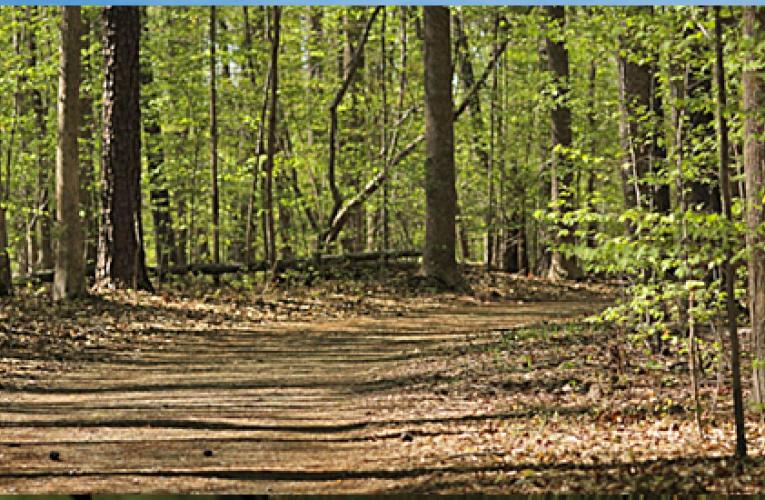DURHAM, N.C. – Visitors heading to Duke Forest this spring to enjoy a walk in the woods will find a network of new and improved trails to explore.
The trails, the first section of which opened earlier this month, provide hikers with better access to sites along New Hope Creek, including the creek’s rare rhododendron bluffs, which are among the most popular destinations in the entire Duke Forest trail system.
The new trails are located in the forest’s Korstian Division. They can be reached via Gate 26, along Whitfield Road. Signposts mark the entry to the trails on an access road to the left.
The timing of the new trails’ opening couldn’t be better, since the rhododendron bluffs are particularly beautiful in late spring, says Sara Childs, Duke Forest’s program director. Visitors climb a steep wooded trail and emerge onto a rocky crag overlooking New Hope Creek. By May, the crag is typically surrounded by a sea of pink and lilac-colored Catawba rhododendron blooms.
“The Catawba rhododendrons and mountain laurel you find here are much more common in the mountains. In the Piedmont, we have only a few isolated populations on north-facing bluffs. So they are a unique natural community type,” Childs says. The bluffs have always been a popular destination, she notes. When the Korstian Division of Duke Forest was officially established in 1931, some walking trails already ran through the area.
Over the years, heavy foot traffic degraded the original trail and severely damaged the surrounding ecosystem.
“It really was not a great trail to go up and down; erosion around the water bars had created a series of strenuous steps to climb, and there were a lot of tripping hazards - lots of exposed roots,” says Childs.
The new Rhododendron Bluffs Trail network circumvents the problem by leading visitors up the slope along a more gradual, less direct route. Boardwalks and platforms have been installed at key locations to help protect plant communities and improve views.
The new trails are the first that have been intentionally designed and built in previously undisturbed areas of Duke Forest.
“We were reluctant to disturb new areas, but in this case, we’re making a good tradeoff,” Child explains. “We’ll be removing disturbance from a sensitive area and redirecting it, in a way that is intentional, manageable, and maintainable. We’re getting very well-designed trails that deal with water properly and that will help confine the recreational impacts to just the trails themselves.”
Childs and Judson Edeburn, Duke Forest’s resource manager, are overseeing the development and building of the new trail system.
Later this spring, work will begin on Phase Two of the project, which will focus on improving the trails downstream from the bluffs, including the New Hope Creek South Trail and the Slick Hill Foot Trail.
The new trails were designed and are being built in collaboration with Stewart Bryan of Native Trails, Inc., and with expert advice from members of the scientific and recreational communities.
“Even though Duke Forest is privately owned by Duke University, it was important for us to seek outside input,” Childs explains. “When you’re managing natural resources for multiple uses, you have multiple stakeholder groups. It’s important to get their input early. The insight and perspective they provide helps you as the manager make a better final decision. It also helps you maintain good relationships, and you can't be an effective manager without good relationships.”
Childs is enthusiastic about the teaching and research opportunities the new trail-building projects provide.
“Since Duke Forest’s primary mission is as a teaching and research laboratory, it’s really exciting to think about and promote the use of our management activities for these purposes,” she says.
Last fall, students in an undergraduate course on restoration ecology led by Rebecca Vidra, lecturer and director of undergraduate studies at Duke’s Nicholas School of the Environment, did class projects on the restoration of the rhododendron bluffs and a road closure that is part of the larger trail-building project. Another Duke undergraduate collected baseline data on disease incidence among the rhododendrons as her senior thesis.
Graduate students in a course led by Yu-Fai Leung, professor of parks, recreation and tourism management at North Carolina State University, also have used the project to research the ecological impacts of recreation and the effectiveness of signage.
To learn about additional research or teaching opportunities, or to volunteer for Phase Two of the trail building, contact Childs at sara.childs@duke.edu.
Visitors to the new trails are asked to stay on the clearly marked paths and keep pets leashed, to help protect the recovering ecosystem.
Updates and images of the trail-building process are available online athttp://dukeforestproject.wordpress.com/korstian-trails-project/.
